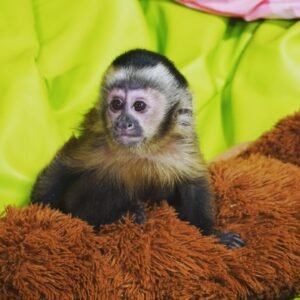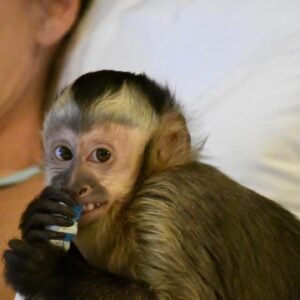Male white-fronted capuchins usually weigh an average of 3.4 kg (7.5 lb) and the females an average of 2.9 kg (6.4 lb), although a male on Mirití-Paraná in Colombia weighed 5.5 kg (12 lb).[20] This primate is usually maroon-white or palomino and creamy white. It has short fingers and an opposable thumb.[21] Like other capuchins its premolars are large, and it has square-shaped molar with a thick enamel to help with cracking nuts.[21] Below are descriptions of the known species for Colombia.
- Humboldt’s white-fronted capuchin, Cebus albifrons, is found in eastern Vichada, close to the type locality, and was defined by von Humboldt using a tame animal maintained by humans (and a pig) in the village of Maipures.[2] The original description of von Humboldt described an ashy gray animal with a black tail tip,[2] characteristics that are not typical of any known population of white-fronted capuchin. The C. albifrons located three kilometers to the north of Maipures are very light colored animals with yellowish or reddish tones, very similar to the population of Arauca.
- Spix’ white-fronted capuchin, Cebus unicolor[5] is also very light colored with yellowish tones and was once thought to be a likely synonym of C. albifrons.[3] One population of very pallid coloration is found in Arauca, the northern part of Boyacá and the eastern part of Norte de Santander and probably represents C. a. albifrons.
- The Río Cesar white-fronted capuchin, Cebus cesarae is very light in color and quite well-defined as a subspecies. “The cap is cinnamon or snuff-brown; median dorsal region, forearm and forelag with orangeous and contrasted with sides of back and trunk; hairs of belly and chest ochracous-orange to pale ochraceous-buff and silvery; contrasting pale area of front extending over variable amounts of upper surface of shoulder and inner side of upper arm” (Hershkovitz, 1949).[6]
- The Santa Marta white-fronted capuchin, Cebus malitiosus, is characterized by a color that is rather dark brown over almost the entire body with yellowish shoulders. “Pale area of front less extensive, upperparts and limbs paler than in hypoleucus. Cap prout’s brown, median dorsal region cinnamon brown, forearm and foreleg not markedly contrasting in color with back and sides of body; hairs of belly and chest ochraceous-tawny to cinnamon-brown and silvery; contrasting pale area of front extending well over upper surface of shoulder and inner side of upper arm” [22](Hershkovitz, 1949).[6]
- The varied white-fronted capuchin, Cebus versicolor, is a complex which includes dark populations and lighter populations.[23] It includes the former subspecies C. a. pleei.[6] and was once thought to also include the Sierra de Perijá white-fronted capuchin, C. leucocephalus.[24] Herskovitz’s description of C. a. pleei is of a very reddish animal, particularly in its limbs while his description of C. a. versicolor is a lighter red.[6] He described C. a. leucocephalus as a dark brown animal with reddish tonalities in the hind legs.[6] Nevertheless, Hernández-Camacho and Cooper discussed evidence that the three subspecies (C. a. leucocephalus, C. a. pleei and C. a. versicolor) could be subsumed into one subspecies (C. a. versicolor), since the variations seem to be found in a very well-defined zone and even in the same groups, close to Barrancabermeja on the eastern bank of the middle Magdalena River in the Department of Santander.[4] This suggested to them that the dark phase (C. a. leucocephalus) and the light phase (C. a. pleei) are extremes of an intermediate (C. a. versicolor).[4] Boubli’s research suggested that C. a. pleei may be synonymous with C. versicolor but was more likely synonymous with C. cesarae, which he found to be closely related to C. versicolor.[16] Boubli found C. a. leucocephalus to be a separate species.[16]
- The shock-headed capuchin, Cebus cuscinus, is found south of the Guamués River and colored a light brown.[6][7]





Reviews
There are no reviews yet.